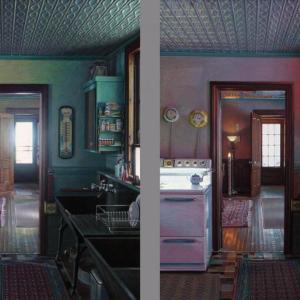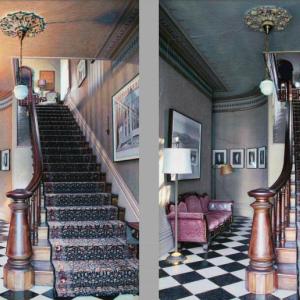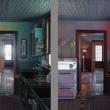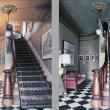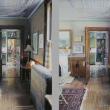‘The sad beauty of time passing’ reflects in artist Eric Green’s latest drawings
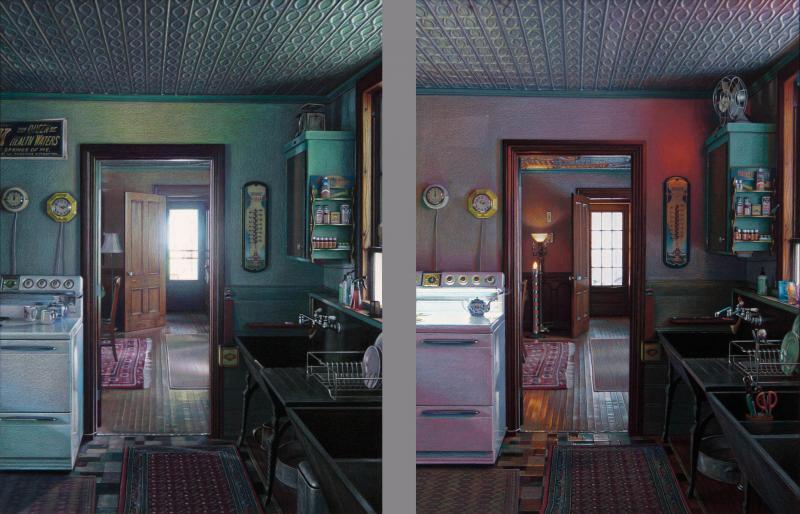 ‘Maiden,’ one of Eric Green’s 10 ‘Time Diptychs,’ featuring rooms in his Victorian house. Notice the light and composition differences between the two panels, as well as what appears and disappears. (Courtesy Eric Green)
‘Maiden,’ one of Eric Green’s 10 ‘Time Diptychs,’ featuring rooms in his Victorian house. Notice the light and composition differences between the two panels, as well as what appears and disappears. (Courtesy Eric Green)
 Belfast artist Eric Green. (Courtesy Eric Green)
Belfast artist Eric Green. (Courtesy Eric Green)
 ‘Matches,’ a ‘Time Diptych’ of Eric Green’s front hallway. Note the light change in the two panels, which reflects a time difference of 20 minutes. (Courtesy Eric Green)
‘Matches,’ a ‘Time Diptych’ of Eric Green’s front hallway. Note the light change in the two panels, which reflects a time difference of 20 minutes. (Courtesy Eric Green)
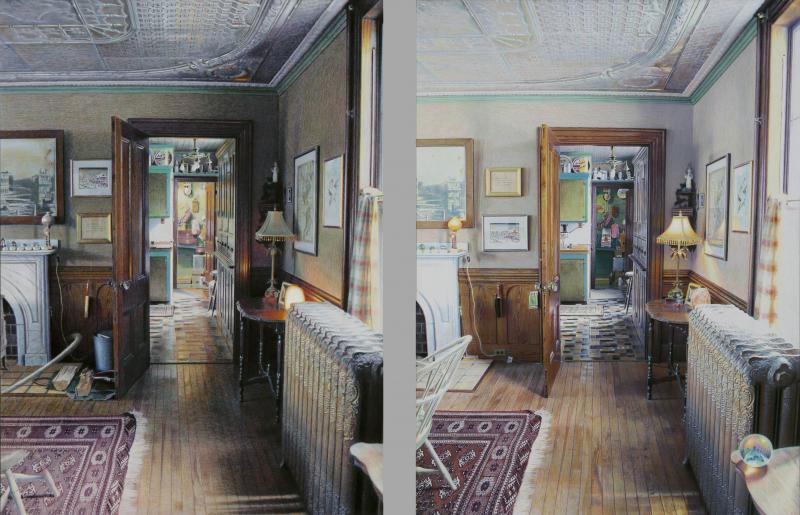 ‘Salt Lamp,’ a ‘Time Diptych’ where objects move around, appear and disappear between the two panels. (Courtesy Eric Green)
‘Salt Lamp,’ a ‘Time Diptych’ where objects move around, appear and disappear between the two panels. (Courtesy Eric Green)
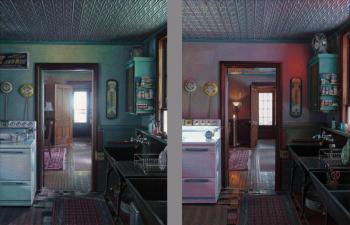 ‘Maiden,’ one of Eric Green’s 10 ‘Time Diptychs,’ featuring rooms in his Victorian house. Notice the light and composition differences between the two panels, as well as what appears and disappears. (Courtesy Eric Green)
‘Maiden,’ one of Eric Green’s 10 ‘Time Diptychs,’ featuring rooms in his Victorian house. Notice the light and composition differences between the two panels, as well as what appears and disappears. (Courtesy Eric Green)
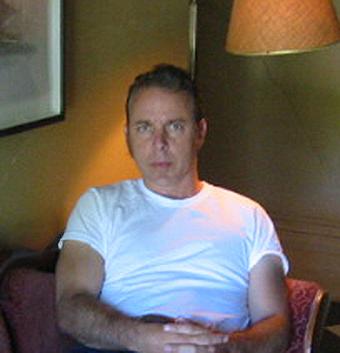 Belfast artist Eric Green. (Courtesy Eric Green)
Belfast artist Eric Green. (Courtesy Eric Green)
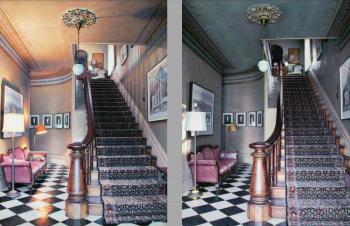 ‘Matches,’ a ‘Time Diptych’ of Eric Green’s front hallway. Note the light change in the two panels, which reflects a time difference of 20 minutes. (Courtesy Eric Green)
‘Matches,’ a ‘Time Diptych’ of Eric Green’s front hallway. Note the light change in the two panels, which reflects a time difference of 20 minutes. (Courtesy Eric Green)
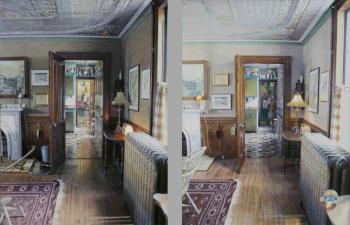 ‘Salt Lamp,’ a ‘Time Diptych’ where objects move around, appear and disappear between the two panels. (Courtesy Eric Green)
‘Salt Lamp,’ a ‘Time Diptych’ where objects move around, appear and disappear between the two panels. (Courtesy Eric Green)
ROCKLAND — During the last Rockland Art Walk, Dowling Walsh Gallery was packed, as it usually is. But, something odd was happening. People weren’t just sipping wine and stopping to pause at a particular painting for several moments, before ambling on. On the right side of the gallery, people were lined up, sometimes two, three deep and staring at particular drawings. Just flat out staring—their eyes moving a fraction to the left, then to the right. To the left again. No one was moving.
Turns out local artist Eric Green, of Belfast, was the master behind this intense concentration. At first glance, his latest series, Time Diptychs, appears to play an elaborate game of “Spot The Difference.” Each pair of drawings portrays two seemingly identical views of a room in his Victorian home. As your eyes move from the left panel to the right, then back again, you start to notice that there’s a difference in lighting between the two views. That’s obvious. But then, upon looking closer, some objects remain in one panel, while disappearing in the other panel. Some objects like a fan, turn into a scale in the next drawing. Then, there’s the hidden movement. One view of a room might look pristine, undisturbed, yet in the next panel, subtle clues — like a kettle singing on the stove — suggest that a person has just been in the room. But wait, which drawing holds the truth?
“The concept of a diptych of two images joined to make one is a very old concept,” said Green. “The way I balance the two images is to show changes from one panel to the other, because when you really begin to understand life, everything changes completely all the time. Nothing is ever the same again.”
That is a crafty way of getting people to really look and spend an inordinate time getting lost in art.
“With the bombardment of media today, we forget the simple pleasures of just seeing,” said Green. “There’s been a tendency in the last 50 years of art to ‘get it’ in the first few seconds and then just walk away. I hope that having the two panels to compare, it slows people down and they want to spend some time to see. Even if it’s just to figure out what’s different between the two panels, but it’s the beginning of learning how to really look and see something.”
The Victorian house, which is the subject of his drawings, has its own story. Green was born in New Hampshire and grew up in what he described as “a modest ranch in a mill town neighborhood, decorated with a few pieces of Danish modern furniture, alongside the furniture my father banged together in an economic Spartan style. For instance, my bed was a sheet of three-inch foam rubber resting on plywood surrounded by knotty pine with a flannel sleeping bag on top.”
He was enamored of an old Queen Anne Victorian his godmother owned that he often came back to visit. “I love patina. I love cracks. I love wear and the sense of time in things,” he said. This childhood experience led him to the Victorian house that he and his wife now own, but it would take a decade before that could happen. Green fell in love with this house the first time he saw it in the mid-1980s, but it was too expensive. He thought about this house for the next 10 years, hoping one day he would own it. The price finally came down, and after his first show was a success in New York, he was able to buy it in the mid-1990s. Then it took 18 years to fully restore. He did all the work himself from rebuilding the windows, redoing the floors, and adding larger architectural elements, such as tin ceilings and a black and white checked floor in the foyer, to the tiniest details like a rewired lamp, as if he had imagined every detail he loved in a painting and placed it physically within the house.
When Green stepped back to view each room in his house, he could see through the passing minutes, something else was going on.
“The house is important, but what is more important in the drawings is the emotional feeling of the time of day, the light, the texture and the incredible poignancy of time passing,” he said. “I call this the sad beauty of time passing.”
A professional artist for the last 40 years, he set forth to capture the variations of light, texture and mood into an entirely unique series of drawings — 10 in all — which took 19 months to create without a day off.
“I made this world I live in, because I love it,” he said. “Then I decided to draw it. Compositionally, it already satisfied my eye as an artist. So, I sort of created this work twice.”
In his diptych, Matches, which features his front stairwell, the actual time between the rendering of both panels was only 20 minutes apart. “You can see the reflection of the light in the newel post. One side is bluer. And the incandescent lights are turned on in the hallway. But, without comparing that to the other side, you wouldn’t know it. You really get a sense of this newel post because you’ve seen it twice, in two different lights.”
As for which panel of each diptych holds the “truth” of the room, Green said, “The principle of the diptych is that you must amalgamate the two panels in your mind, so when you look at it, your mind is combining the two images. The art doesn’t exist in either panel. It’s created by your mind combining both.”
Green first worked in grisaille or a graphite under drawing to sketch the composition and perspective lines. It would then take weeks to finish each drawing with colored pencils, which cannot be erased, once drawn.
“I couldn’t make mistakes, so it was rather nerve-wracking,” he said.
Green, who also is an author of five novels, including his most recent, LiveCell, said working as an artist takes way more out of him than working as an author.
“Sometimes, I hate painting,” he said with a laugh.
The intensity, the shifting perspective and the fact that his work is a statement more about mortality than anything else, makes these diptychs a must-see for anyone who has the time to stop by the gallery. But you must take the time to really, really look.
Eric Green’s Time Diptychs will be shown at Dowling Walsh Gallery in Rockland until Oct. 7.
Kay Stephens can be reached at news@penbaypilot.com.
Event Date
Address
United States

